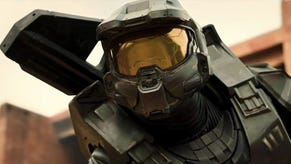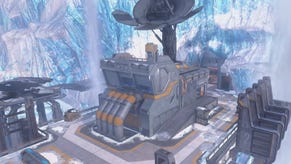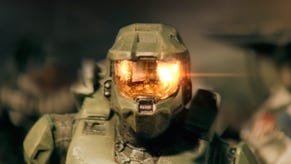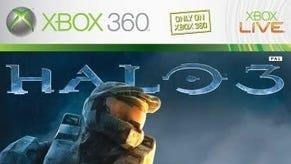Retrospective: Halo 3
With hindsight, the best and worst of 2007's biggest game.
It's not easy for critics to come back to something they liked, or hated, and deal with the division their copy failed to anticipate. But that shouldn't stop us facing up to and exploring differences of opinion. We've tried before, of course, with the infamous BioShock: A Defence, but that wasn't quite the right approach (even if we did enjoy ourselves), so we've come up with something we think is better. In this, the first of our Retrospective pieces on major games of the past 12 months, Oli Welsh and Alec Meer use the hindsight afforded to them by the five months since Halo 3's release and consider the arguments on both sides of the divide. You can read our original Halo 3 review first, if you like, to put it all in context.
Good Cop - Oli Welsh
Take a step back.
Don't pore over the textures and geometry too closely, or the action-figure faces and clumsy hands. Get some distance, some scale, find a vantage point and drink in the incredible view Halo 3 has to offer. Dozens and dozens of men and vehicles swarming and cartwheeling around skyscraper-sized walking tanks, explosions everywhere, coruscating death-rays raking the earth, and in the background a lurid vista of impossible scale, straight off some late-'70s airbrush sci-fi poster. Look at Halo 3 too closely, and it doesn't look too different from what came before. Take in the whole picture at once, and it's nothing short of breathtaking.
Take a step back from the storytelling. It's easy to scorn the pomposity, mawkishness and clunky machismo of the script. It's easy to pick at the loose threads in the story, unravel the gaping holes in the plot. For sure, Halo 3 is not a highly evolved example of the narrative form, and the minutiae of its universe seem both bewildering and pointless. But the grand sweep of it is something else, something universal.

It's far too old and too big to be called a cliché; it's a heroic archetype from mythologies around the world, the doomed journey of the soldier-king. It's a hugely populist story that everyone wants to hear, but Hollywood has failed to tell it in a science-fiction setting in recent years, certainly with the ambition and sheer self-belief that Bungie has. It's no wonder that people have flocked to the tale's climax in Halo 3, even if the details were fudged.
Take a step back from Master Chief. Literally - start a Theatre mode recording, zoom out, and pan the camera across the entire level. See everywhere you're going to be, every enemy you're going to fight. Try to catch the game out in a lazy spawn or sudden lurch into action; there aren't any. It's all there, alive, running and waiting for you. If Sergeant Johnson is going to meet you later, you'll see him emerge from a door and battle Flood on the other side of a building you're nowhere near yet, talking to the Chief and Arbiter on the radio as he clears a path.
It's mind-blowing that Bungie would take the trouble to write that in and use up runtime for it, when most players wouldn't even dream it was there. The developers have been knocked for not pushing or innovating enough with Halo 3, for just giving players what they wanted, but there's no "just" about it. They gave us what we wanted and made it real, every inch of it, nothing missing, nothing broken, nothing faked. They let us use and abuse it however we liked, and they didn't cheat or compromise on one single detail. In its own way, that's revolutionary - it's just that for all the noise the game makes, the revolution in Halo 3 is a quiet one.
Take a step back. And then another, and then another. Drink it all in at once. Halo 3's brilliance is all in the big picture.
It's in the complete absence of smoke and mirrors used in orchestrating the action. This is something Halo 3 shares with both its predecessors, and to be fair, it doesn't advance its basic combat systems very far beyond the usual 'bigger, better, more badass'. But to knock it for that, when those six-year-old systems are still far in advance of its competition, is ludicrous.
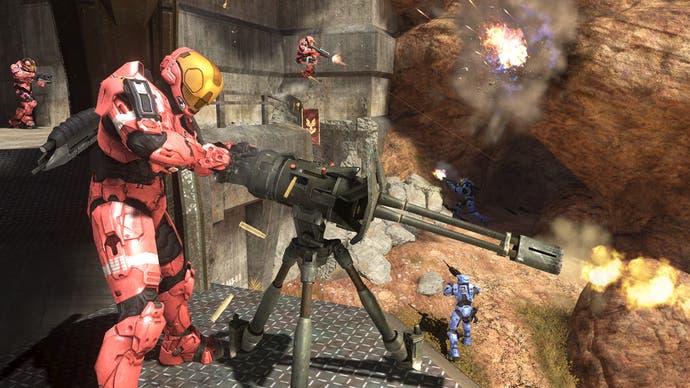
Call of Duty 4 stole much of Halo 3's thunder and critical acclaim at the end of last year, and it's certainly an extremely well-crafted and overwhelmingly powerful experience. But beneath its bluster it's all show, a rudimentary assemblage of the oldest tricks in the book: heavy scripting, respawning enemies, crude event triggers. You don't have to push far past the boundaries of its tightly controlled corridor of fun to see the wizard pulling the wires.
Halo 3, on the other hand, is truly emergent, a game where terrific action storytelling occurs organically from the interaction of the player, multiple AI elements (interacting with each other), and the precarious-but-perfect balance of its weapon, vehicle and enemy designs. It's what aeronautics engineers refer to as "inherently unstable" - an aerodynamic phenomenon where a fighter jet has a natural tendency to change direction, making it harder to control, but much more agile.
Halo 3 is permanently teetering on the brink of total chaos. It never quite goes there, but that instability makes it truly, gloriously unpredictable. From the same checkpoint save it will never, ever play the same twice, and it's the only shooter in existence you can honestly say that about; that's worth a thousand moments of Call of Duty 4's scripted, cinematic intensity. Learning from that is still as vital to the future health of gaming now as it was in 2001, and the way that thinking has been rigorously scaled up in Halo 3 - in the more complex hierarchical structure of the enemy AIs, for example - is all you could ask for.
But the picture gets bigger still. Bungie took this world-beating formula and split it wide open for you, the players, to test to the limits of its endurance. You can play through the campaign in four-player co-op, online, with a customised rule-set of hilariously, viciously extravagant new parameters. You can record hours-long play sessions automatically and obsess over them from any angle. And still the game refuses to break, to stumble, to let its mask slip for a second.
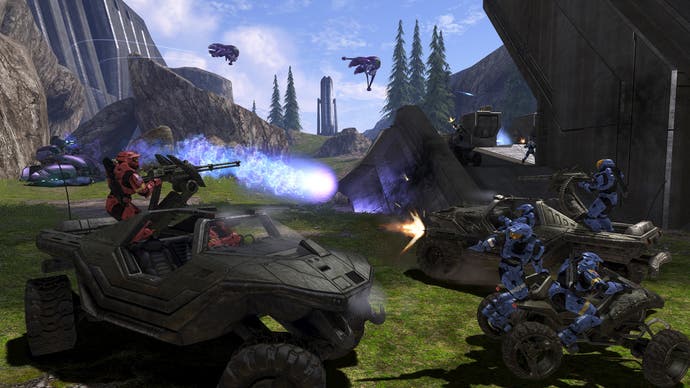
Now take a step back from the campaign. This no-compromise, big-picture philosophy is applied in every corner of the game. Forge's support for 8 players online breathes enough life into this fairly basic map editor to make it an irresistible plaything. The multiplayer, for all that it's a rumbustious show-stopper of a game, would have been left behind by the more sophisticated COD4 and Team Fortress 2 if it wasn't for its support from Theatre mode and Halo 3's own personal Facebook, the insanely detailed and feature-laden bungie.net. Those two facilities make it the most forward-thinking online gaming experience out there, one that the "Game 3.0" era is still racing to keep up with.
Take one last step back, and look at the biggest picture yet. It's right there, on the matchmaking screen: a live map of the world, with glowing dots showing concentrations of online Halo 3 players. This detail sums Halo 3 up. It's a game that puts itself in context, a game that's made by the actions of players, a game that's all about the thrill of the now. That makes it, naturally, ephemeral; firing it up now is never going to be as exciting as it was in the autumn of last year, in those heady weeks when the whole world seemed giddy with Halo 3 madness. But nevertheless, it's a glimpse of the future. One day, all games will be made this way.


